CHEVROLET EXPRESS 1997 1.G Owners Manual
Manufacturer: CHEVROLET, Model Year: 1997, Model line: EXPRESS, Model: CHEVROLET EXPRESS 1997 1.GPages: 386, PDF Size: 20.32 MB
Page 121 of 386
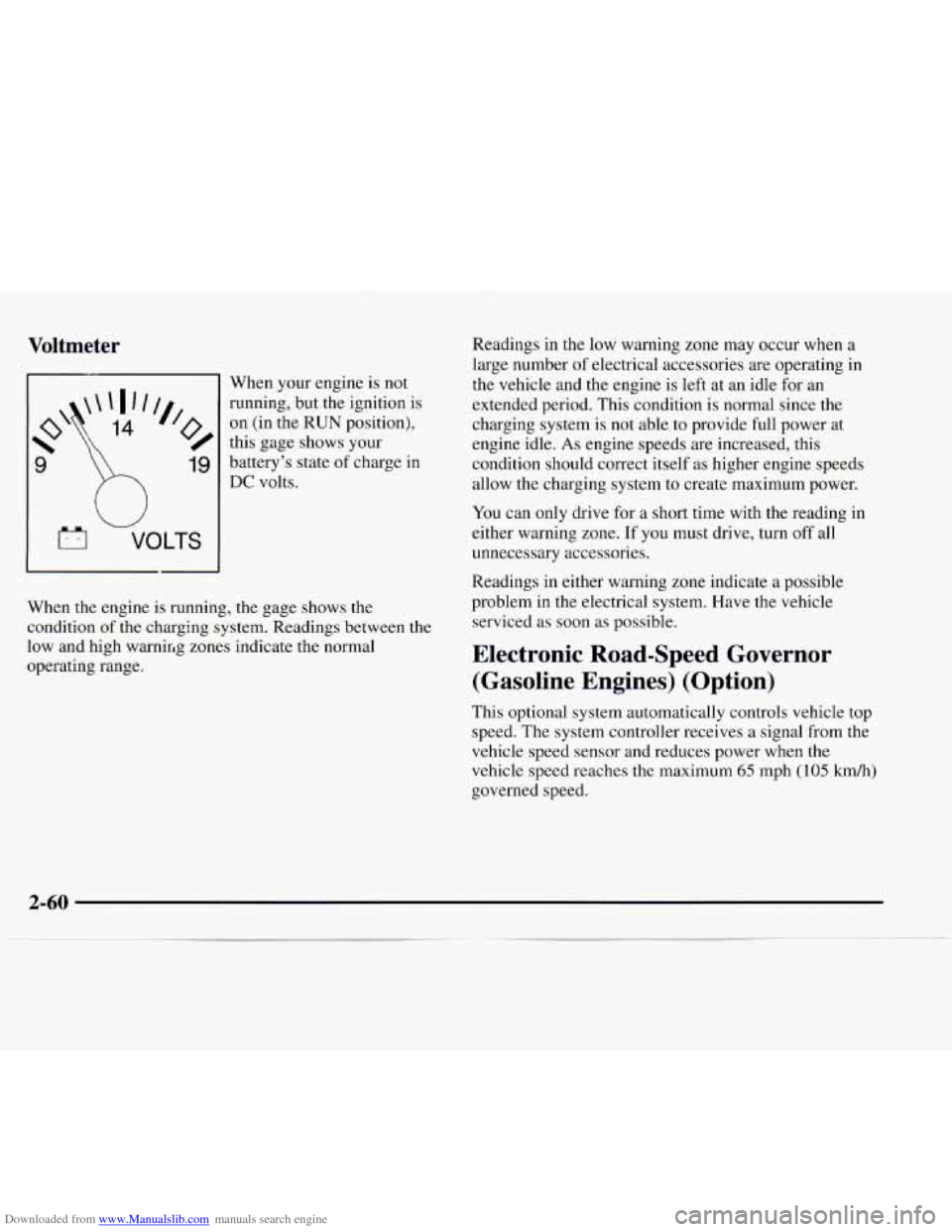
Downloaded from www.Manualslib.com manuals search engine Voltmeter
u
VOLTS
When your engine is not
running, but the ignition is
on (in the RUN position),
this gage shows your
battery’s state of charge in
DC volts.
When the engine
is running, the gage shows the
condition of the charging system. Readings between the
low and high warnir,g zones indicate the normal
operating range. Readings
in the low warning zone may occur when a
large number
of electrical accessories are operating in
the vehicle and the engine is left at an idle for an
extended period. This condition is normal since the
charging system is not able to provide full power at
engine idle.
As engine speeds are increased, this
condition should correct itself
as higher engine speeds
allow the charging system to create maximum power.
You can only drive for a short time with the reading
in
either warning zone. If you must drive, turn off all
unnecessary accessories.
Readings in either warning zone indicate a possible
problem in the electrical system. Have the vehicle
serviced as soon as possible.
Electronic Road-Speed Governor
(Gasoline Engines) (Option)
This optional system automatically controls vehicle top
speed. The system controller receives a signal from the
vehicle speed sensor and reduces power when the
vehicle speed reaches
the maximum 65 mph (105 km/h)
governed speed.
Page 122 of 386
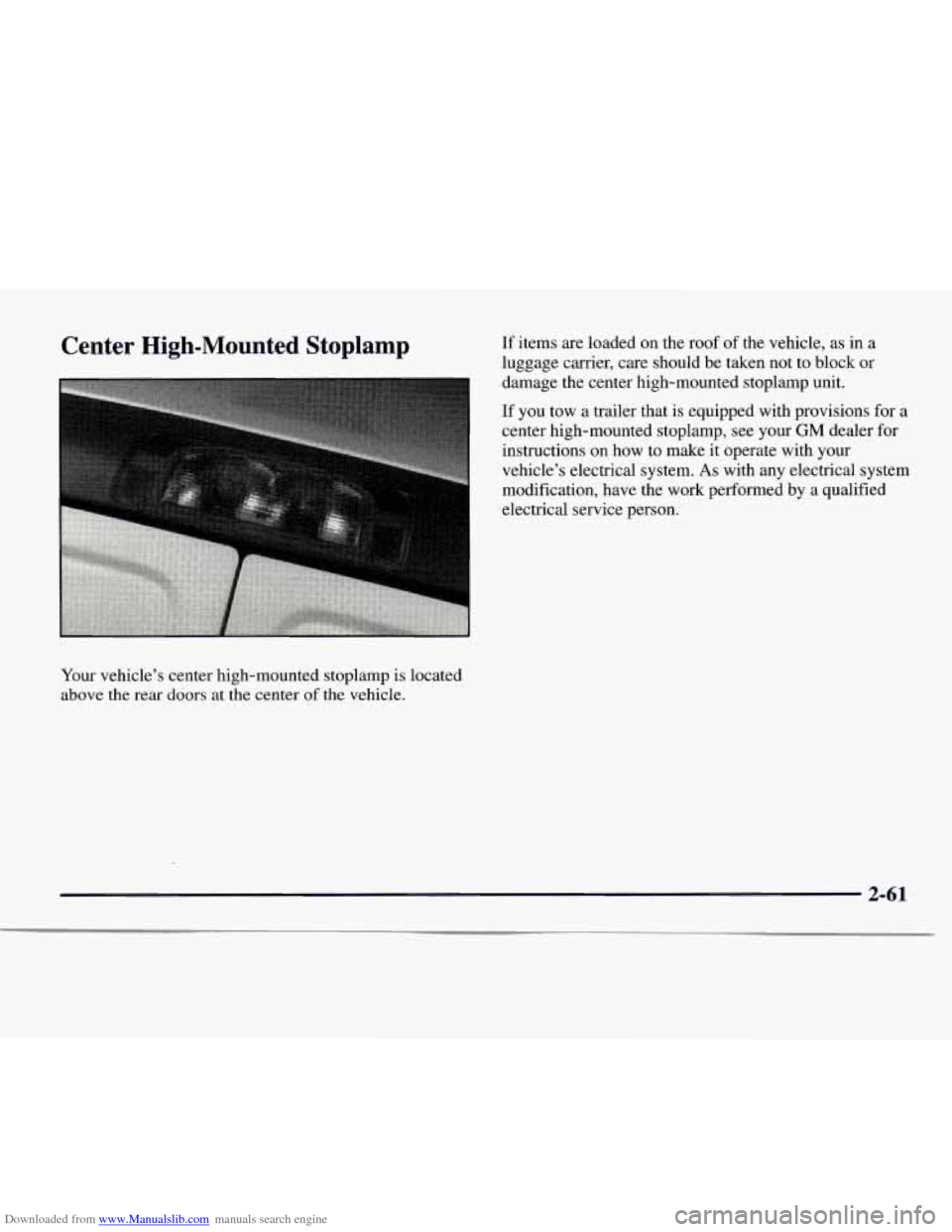
Downloaded from www.Manualslib.com manuals search engine Center High-Mounted Stoplamp
Your vehicle’s center high-mounted stoplamp is located
above the
rear doors at the center of the vehicle. If
items are loaded
on the roof of the vehicle, as in a
luggage carrier, care should be taken not to block or
damage the center high-mounted stoplamp unit.
If you tow a trailer that is equipped with provisions for a
center high-mounted stoplamp, see your
GM dealer for
instructions on how to make it operate with your
vehicle’s electrical system.
As with any electrical system
modification, have the work performed by a qualified
electrical service person.
2-61
Page 123 of 386

Downloaded from www.Manualslib.com manuals search engine fi NOTES
2-62
Page 124 of 386

Downloaded from www.Manualslib.com manuals search engine k% NOTES
Page 125 of 386

Downloaded from www.Manualslib.com manuals search engine kasD NOTES
Page 126 of 386
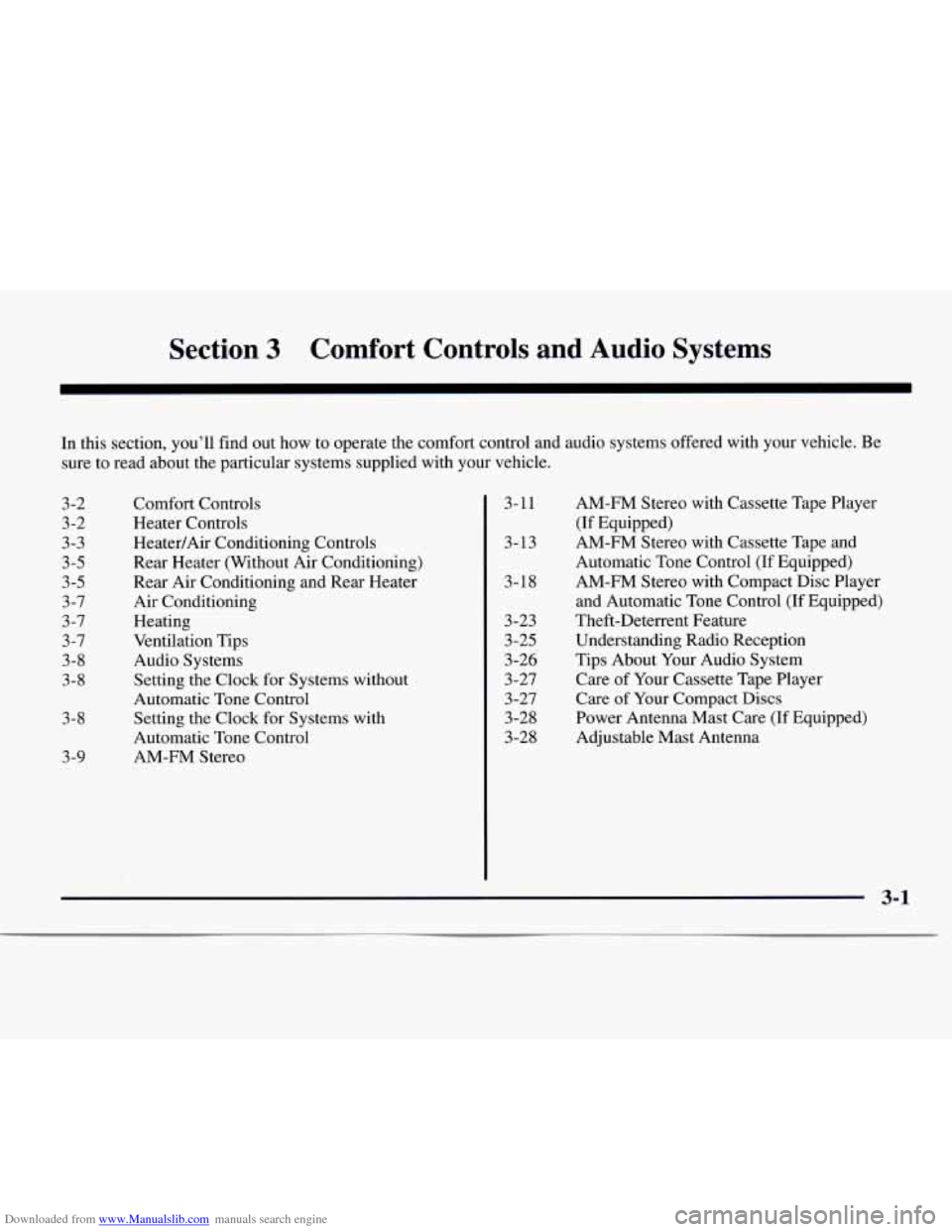
Downloaded from www.Manualslib.com manuals search engine Section 3 Comfort Controls and Audio Systems
In this section, you’ll find out how to operate the comfort control and audio systems offered with your vehicle. Be
sure to read about the particular systems supplied with your vehicle.
3-2 3-2
3-3
3-5
3 -5
3
-7
3 -7
3 -7
3-8
3-8
3-8
3
-9
Comfort Controls
Heater Controls
Heater/Air Conditioning Controls
Rear Heater (Without Air Conditioning)
Rear Air Conditioning and Rear Heater
Air Conditioning
Heating
Ventilation Tips
Audio Systems
Setting the Clock for Systems without
Automatic Tone Control
Setting the Clock for Systems with
Automatic Tone Control
AM-FM Stereo 3-11
3-13
3-18
3-23
3-25
3-26
3-27
3
-27
3-28
3-28 AM-FM
Stereo with Cassette Tape Player
(If Equipped)
AM-FM Stereo with Cassette Tape and
Automatic Tone Control (If Equipped)
AM-FM Stereo with Compact Disc Player
and Automatic Tone Control
(If Equipped)
Theft-Deterrent Feature
Understanding Radio Reception
Tips About Your Audio System
Care of Your Cassette Tape Player
Care
of Your Compact Discs
Power Antenna Mast Care
(If Equipped)
Adjustable Mast Antenna
Page 127 of 386
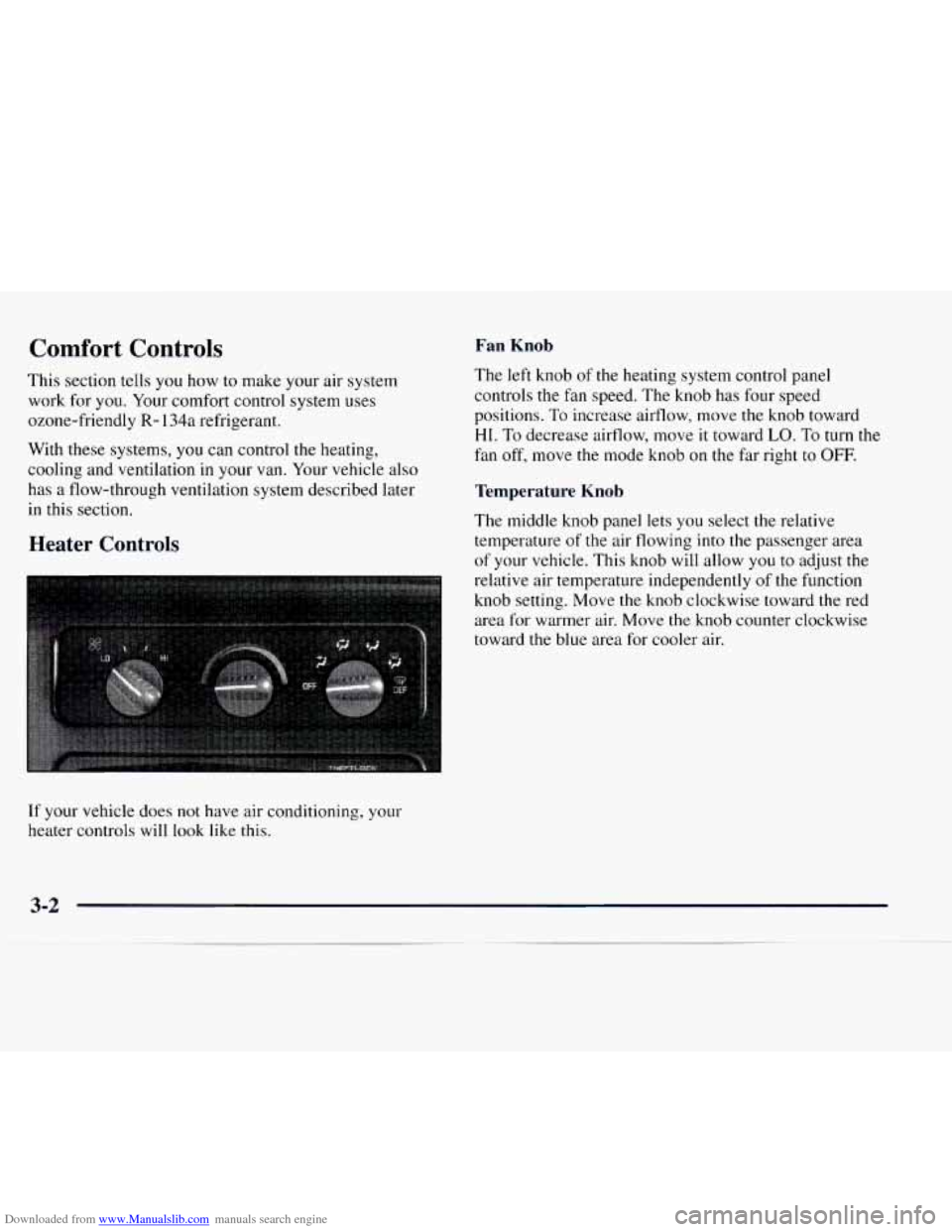
Downloaded from www.Manualslib.com manuals search engine Comfort Controls
This section tells you how to make your air system
work for you. Your comfort control system uses
ozone-friendly
R- 134a refrigerant.
With these
systems, you can control the heating,
cooling and ventilation
in your van. Your vehicle also
has a flow-through ventilation system described later
in this section.
Heater Controls
If your vehicle does not have air conditioning, your
heater controls will look like this.
Fan Knob
The left knob of the heating system control panel
controls the fan speed. The knob has four speed
positions. To increase airflow, move the knob toward
HI. To decrease airflow, move it toward LO. To turn the
fan off, move the mode knob on the far right to OFF.
Temperature Knob
The middle knob panel lets you select the relative
temperature of the air flowing into the passenger area
of your vehicle. This knob will allow
you to adjust the
relative air temperature independently of the function
knob setting. Move the knob clockwise toward the red
area for warmer air. Move the knob counter clockwise
toward the
blue area for cooler air.
3-2
Page 128 of 386
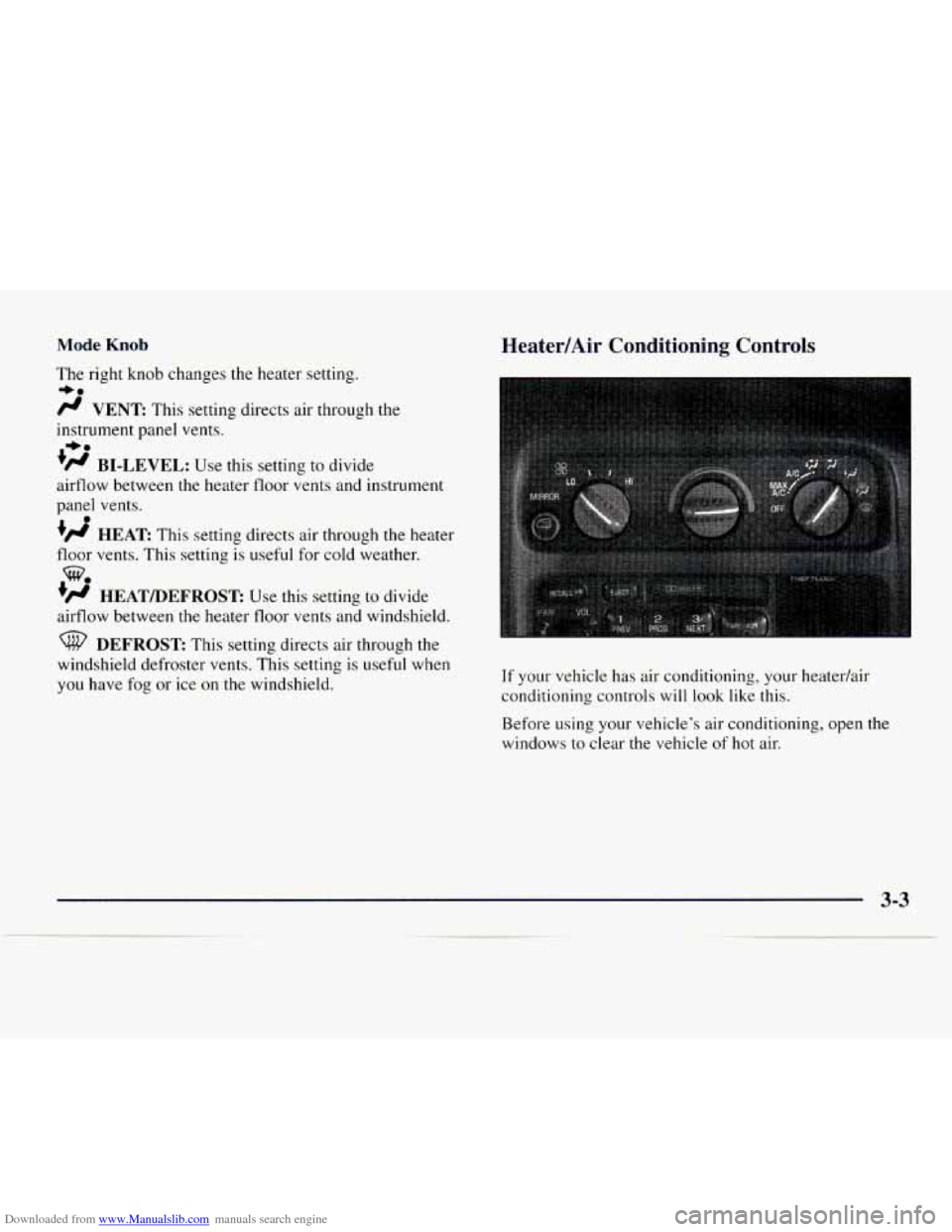
Downloaded from www.Manualslib.com manuals search engine Mode Knob
The right knob changes the heater setting.
/J VENT This setting directs air through the
instrument panel vents.
’# BI-LEVEL: Use this setting to divide
airflow between the heater floor vents and instrument
panel vents.
+# HEAT This setting directs air through the heater
floor vents. This setting is useful for cold weather.
+’, HEATDEFROST Use this setting to divide
airflow between the heater floor vents and windshield.
*a
+e
e
wa
DEFROST: This setting directs air through the
windshield defroster
vents. This setting is useful when
you have fog or ice on the windshield.
Heater/Air Conditioning Controls
If your vehicle has air conditioning, your heatedair
conditioning controls will look like this.
Before using your vehicle’s air conditioning, open the
windows
to clear the vehicle of hot air.
Page 129 of 386
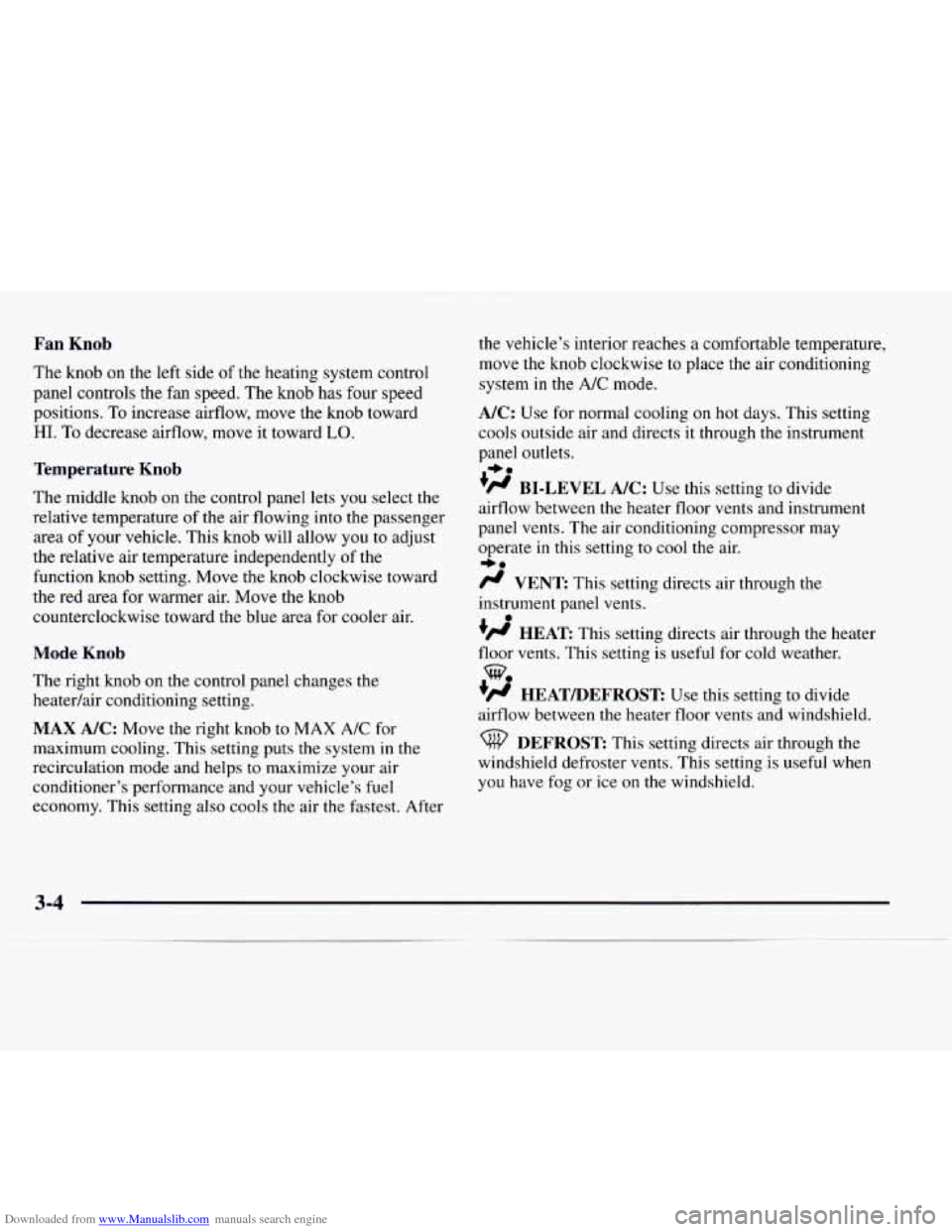
Downloaded from www.Manualslib.com manuals search engine Fan Knob
The knob on the left side of the heating system control
panel controls the fan speed. The knob has four speed
positions. To increase airflow, move the knob toward
HI. To decrease airflow, move it toward LO.
Temperature Knob
The middle knob on the control panel lets you select the
relative temperature of the air flowing into the passenger
area
of your vehicle. This knob will allow you to adjust
the relative air temperature independently
of the
function knob setting. Move the knob clockwise toward
the red area
for warmer air. Move the knob
counterclockwise toward the blue area for cooler air.
Mode Knob
The right knob on the control panel changes the
heatedair conditioning setting.
MAX A/C: Move the right knob to MAX A/C for
maximum cooling. This setting puts the system in the
recirculation mode and helps to maximize your air
conditioner’s performance and your vehicle’s fuel
economy. This setting also cools
the air the fastest. After the vehicle’s interior reaches
a comfortable temperature,
move the knob clockwise to place the air conditioning
system in the
A/C mode.
A/C: Use for normal cooling on hot days. This setting
cools outside air and directs it through the instrument
panel outlets.
‘fl BI-LEVEL A/C: Use this setting to divide
airflow between the heater floor vents and instrument
panel vents. The air conditioning compressor may
operate in this setting to cool the air.
/J VENT This setting directs air through the
instrument panel vents.
+H HEAT This setting directs air through the heater
floor vents. This setting is useful for cold weather.
+# HEATmEFROST: Use this setting to divide
airflow between the heater floor vents and windshield.
+e
I,.
0
we
DEFROST This setting directs air through the
windshield defroster vents. This setting is useful when
you have fog or ice
on the windshield.
3-4
-
Page 130 of 386
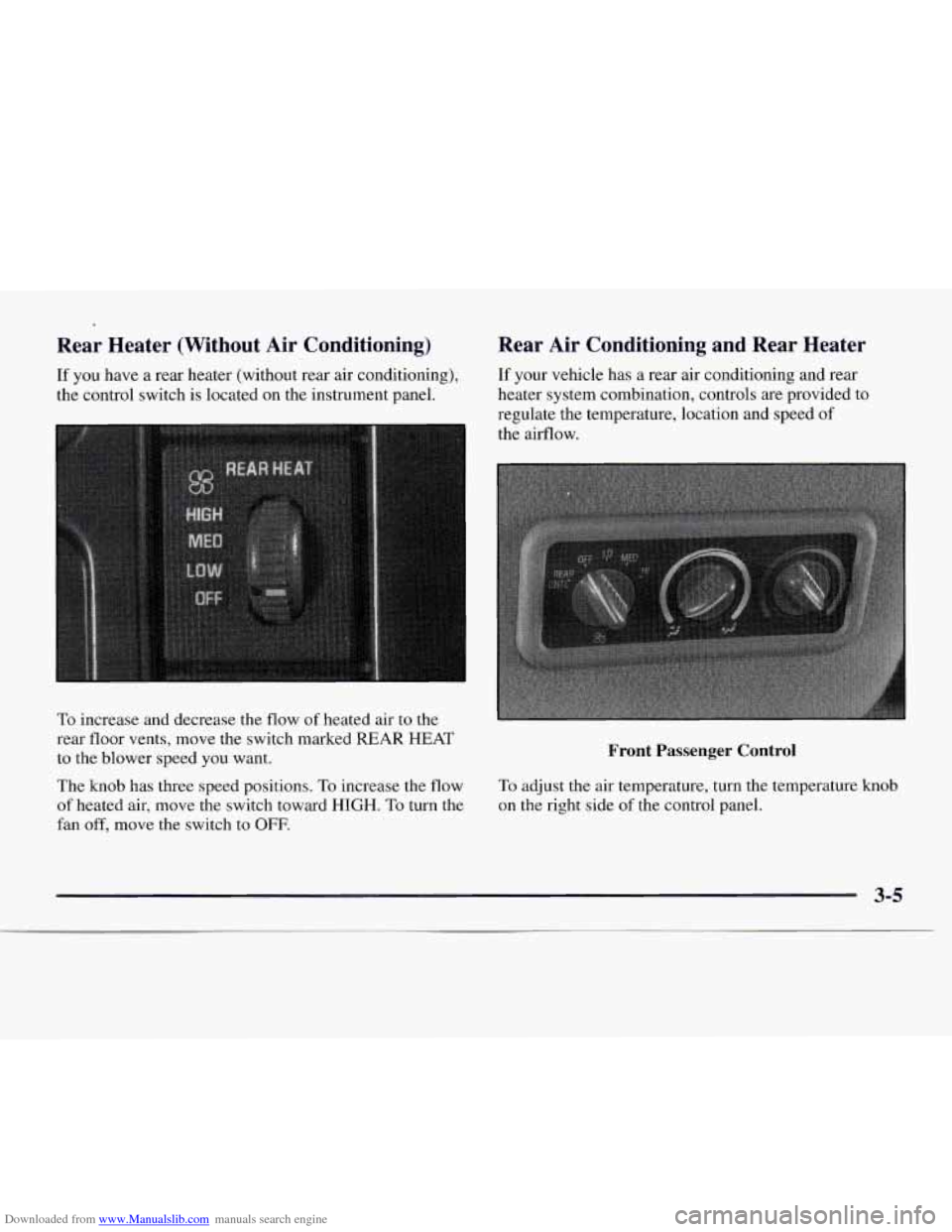
Downloaded from www.Manualslib.com manuals search engine Rear Heater (Without Air Conditioning)
If you have a rear heater (without rear air conditioning),
the control switch is located on the instrument panel.
To increase and decrease the flow
of heated air to the
rear floor vents, move the switch marked REAR HEAT
to the blower speed you want.
The
knob has three speed positions. To increase the flow
of heated air, move the switch toward HIGH. To turn the
fan
off, move the switch to OFF.
Rear Air Conditioning and Rear Heater
If your vehicle has a rear air conditioning and rear
heater system combination, controls are provided to
regulate the temperature, location and speed
of
the airflow.
Front Passenger Control
To adjust the air temperature, turn the temperature knob
on the right side
of the control panel.
3-5